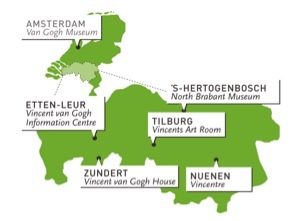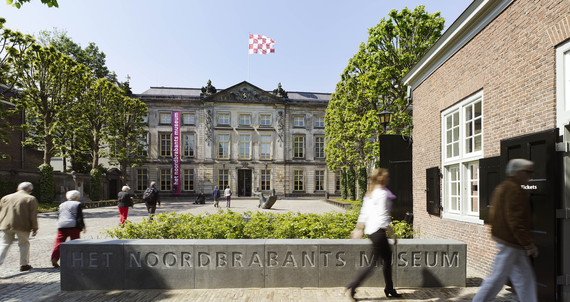Key Early Masterpieces Return to the Artist's Home Province -- And More.
"There will always be something of the Brabant fields and heath in us I hope... "
-- Vincent van Gogh in a letter to his brother Theo, 24 November 1882
It is a happy problem for enthusiasts like me that there are so many possibilities to walk in the footsteps of Vincent van Gogh today, nearly 125 years after the artists' death. For during the 37 years of his short life, Vincent called no fewer than 38 places home in the Netherlands, Belgium, England and France. While only one of his actual homes still survives and operates in its original state (that would be The Auberge Ravoux in Auvers-sur-Oise, France where Vincent lived his last 70 days, where he died, and where his funeral was held) landmarks, relics, unchanged sites of his great works and of course museums abound throughout the aforementioned countries -- and beyond.
But to really know Vincent, one must know Brabant -- the southernmost Province of The Netherlands and the place where he was born, raised and where a solid base was forged which would go on to define his world view and his artistry. As the Van Gogh Brabant website puts it: the masterpieces of Van Gogh are spread throughout the world, but their roots lie in Brabant.
And the best time to get to know Brabant is now.
For starters, the Noordbrabants (North Brabant) Museum, renowned for its historic collections of Roman archaeology, Flemish paintings from 1500-1800 and art from 1800 has just unveiled its 'Story of Brabant' series, illustrating the artistic and cultural history of the region over the past six centuries by means of historical objects, works of art and audiovisual presentations. The series includes 11 paintings by Vincent -- the largest semipermanent presentation of original works ever in his home Province (In fact, it's been 2 1/2 years since any of his works have been on display in Brabant at all due to the extensive, just-completed renovations to the museum).
Charles De Mooij, Director of The Noordbrabants notes:
"Given that Van Gogh was born and raised in Brabant, and took the crucial step of becoming an artist here, it is vital that original work from his early period is permanently exhibited in his home province. Visitors regularly come to the museum just for Van Gogh. After their visit here they can, if they wish, explore the landscape and locations that inspired him, all of which are within an easy distance of the museum. Van Gogh is an important player in 'The Story of Brabant', and the story would not be complete without him."
With the exception of Self-Portrait with Pipe from 1886 -- on permanent loan from the exquisite Van Gogh Museum in Amsterdam (another must-see, of course) -- the new exhibit concentrates on works from Vincent's Brabant period: peasant dwellings, examples of peasant life, paintings of peasant heads, a still life, and also a painting of the Vicarage in Nuenen. Together, they tell the story of the artist's origins and his intense fascination with peasant life.
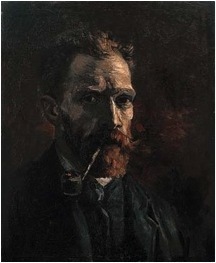
'Self-portrait with Pipe', Vincent van Gogh, 1886, Oil on canvas, 46 x 38 cm, Van Gogh Museum (Vincent van Gogh Foundation)
In addition, two exceptional loans from billionaire Carlos Slim's Museo Soumaya in Mexico City will be on display for the next six months: Shepherd (1884) and Cottage with Peasant (1885). The former work was last to be seen in the Netherlands in 1903, the latter in 1950. Regarding the Slim loans, De Mooij notes; "The two paintings from the collection of Carlos Slim are important additions as they illustrate aspects of Van Gogh's development as a painter that would otherwise not be represented. Shepherd was a commission from his 'pupil' Antoon Hermans and therefore, unlike most works from this period, painted for a specific purpose and location -- Herman's dining room. Cottage with Peasant represents Van Gogh's move, on the advice of his brother Theo, towards a lighter color palette. The painting is an important forerunner of his later French work, and dramatically different to his other Brabant paintings in its use of light."
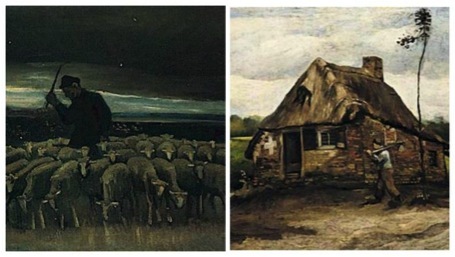
Left: 'Shepherd', Vincent van Gogh, 1884 Oil on canvas, 67 x 126 cm; Right: 'Cottage with Peasant', Vincent van Gogh,1885, Oil on canvas, 65.5 x 78.5 cm. Both loans from the Museo Soumaya Fundación Carlos Slim, Mexico
In addition to the doings at The Noordbrabants, Brabant is honoring its favorite son with special care. Here in his home Province, a number of towns -- such as Zundert, Nuenen, Tilburg, Etten-Leur and 's-Hertogenbosch -- have very strong bonds with Vincent as well. Within them, many traces of the artist remain today, for example, the Vincent van GoghHuis (Van Gogh House) on the site of his birthplace in Zundert, the art room at his school in Tilburg, and the Dutch Reformed Churches where Dorus, the Van Gogh patriarch, was a minister. A quarter of all of Vincent's works were painted in Nuenen, including his first masterpiece The Potato Eaters (1885). So it should be no surprise that 21 buildings and locations in the vicinity still provoke memories of him in what is essentially a living outdoor museum -- where the modern landscape exists in surprisingly similar fashion to how it was in Vincent's day.
Said Frank van den Eijnden, Director of Van Gogh Brabant; "In places like Zundert, Etten-Leur, Tilburg and Nuenen visitors can experience the physical heritage of Vincent van Gogh. With the renovated Noordbrabants Museum the art is also accessible, making it the only place where the Brabant art is fully displayed. This shows the context in which Van Gogh developed and turned into an artist. It shows the correlation between all Brabant and later French work."
There are some interesting and typically Dutch modern takes on the Van Gogh Brabant experience in the works as well, such as an innovative addition to the already-popular Van Gogh Cycling Tour -- a 600 meter long innovative cycle path inspired by the iconic painting Starry Night that will be opened by the end of the year. The path has a special interactive design, created by Dutch designer Daan Roosegaarde, which makes use of the 'Smart Highway' concept combining sustainable techniques with actual reaction to surroundings and cyclists. For example, small stones which charge during the day and light up at night to create patterns of twinkling stars in the paths.
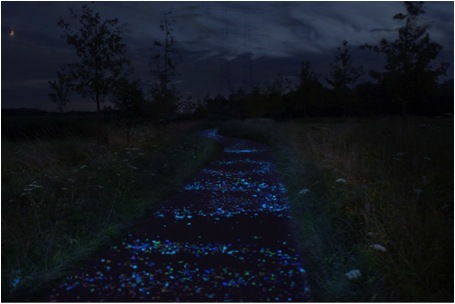
Innovative cycle path near Eindhoven designed by Daan Roosegaarde. Expected completion: Autumn 2014
Finally, Van Gogh enthusiasts should already have noted 2015 as the 125th anniversary of Vincent's death due to attemped suicide. Together with the Van Gogh Europe Foundation, the Noordbrabants Museum and the different heritage sights in Brabant are -- in close collaboration with multiple other partners -- planning to mark the occasion in unprecedented style. Interested? Keep an eye on the links below as the details are rolled out over the next few months:
www.noordbrabantsmuseum.nl
www.vangoghbrabant.com
www.vangogheurope.eu
Photo of Noordbrabants Museum by Joep Jacobs

